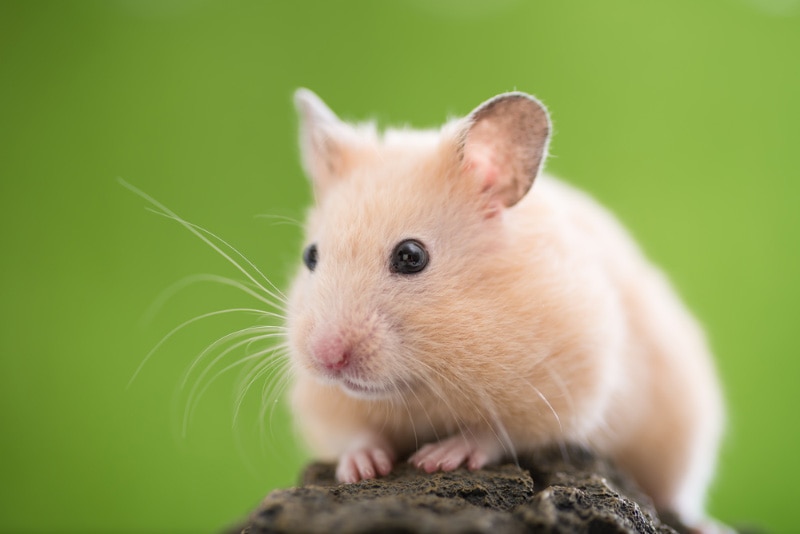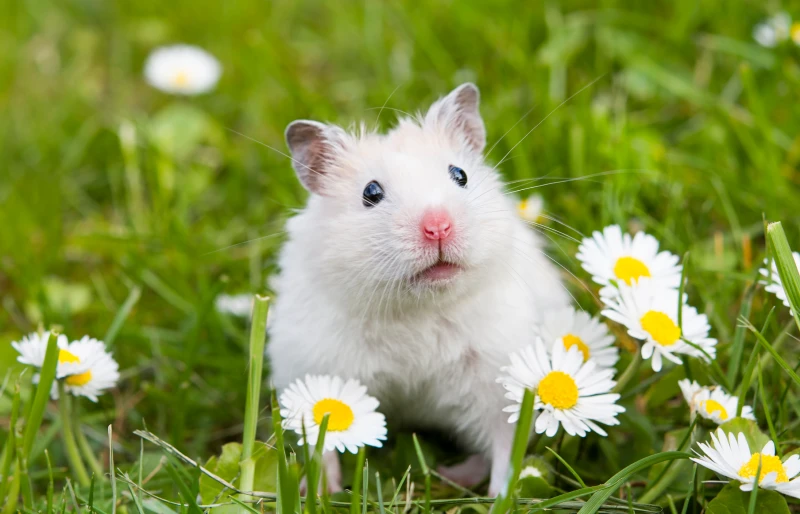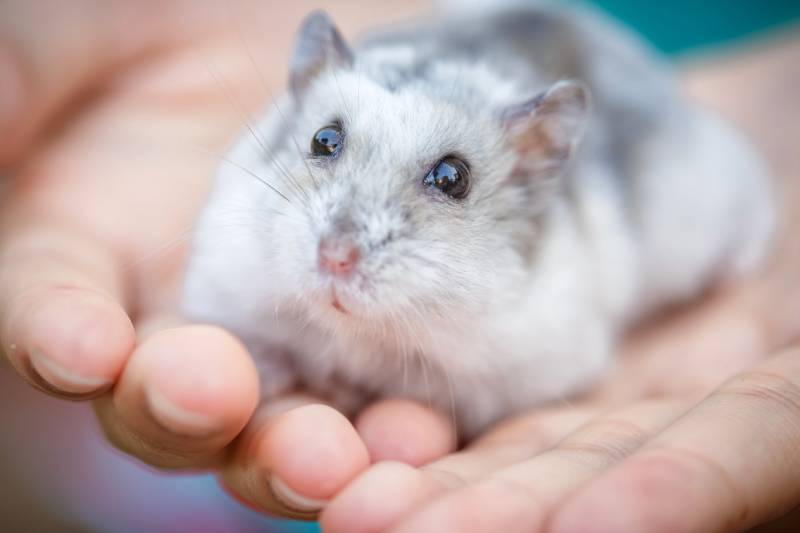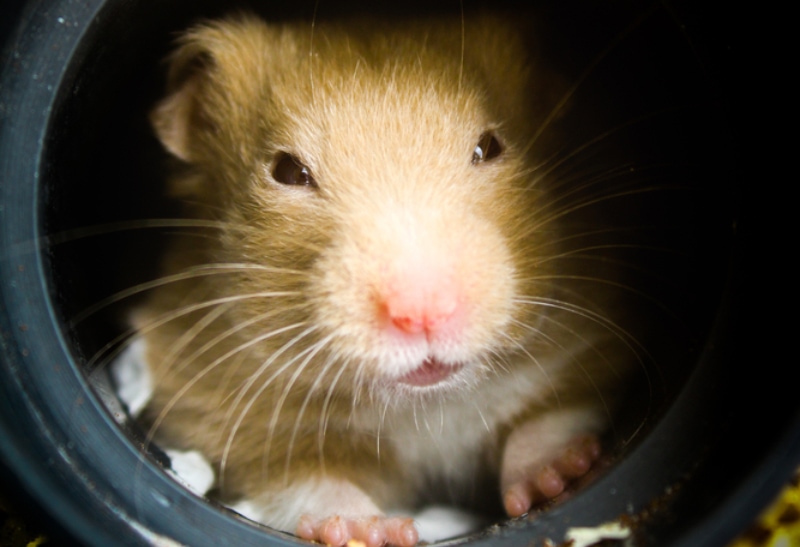Can Hamsters See Color? Rodent Vision Explained (Vet-Verified)
Updated on

Click to Skip Ahead
Like other rodents, hamsters do not have excellent eyesight, as they are nocturnal animals. They use their other senses, such as smell and touch, to determine their surroundings more than they use their vision. Hamsters also have limited color vision—they’re thought to be able to differentiate between green and blue, thus being considered dichromats. Fortunately, great vision and the ability to see color doesn’t dampen a hamster’s ability to thrive in life.
How a Hamster’s Vision Works
A hamster’s vision is designed for nighttime use, as they naturally sleep all day in the wild and only come out of their burrows when it’s dark outside and the risk of getting caught by prey is lower. Their eyes have many more rod photoreceptors than cone photoreceptors. These are the two types of light sensitive cells, which are in charge of converting light into electrical impulses that are then sent to the brain via the optic nerve. Hamsters’ retinas contain 97% of rods and 3% of cones, thus justifying their nocturnal habits.
Cone photoreceptors help make color vision possible, while rod photoreceptors allow vision in very low light conditions. Unfortunately, nobody knows exactly how hamsters see; we just know that their sight is limited. Fortunately, they don’t have to rely on their eyesight to get along in life.

How Hamsters Survive With Poor Eyesight
Hamsters have evolved to have limited eyesight because their other senses serve them better when living in the wild. Since they tend to sleep more during the day and become active at night, they can make the most of the little light available at night. So, hamsters focused on developing strong smell, hearing, and touch senses that would better serve them in a dark environment.
Hamsters can hear low and high frequencies, which enables them to communicate with each other and hear predators from a distance. Hamsters often freeze in place to listen harder when they hear something that could be predatory. You might see this happen with your own hamster in their habitat, even if you don’t hear anything yourself. Their hearing is far better than yours!
A hamster’s excellent sense of smell helps them seek out suitable food and even determine what sex a nearby hamster is for mating reasons. Smell is also important for communication, as hamsters release pheromones that produce a unique scent that other hamsters can pick up on. This helps a hamster tell where another hamster has been, whether a strange hamster is in their burrow, and whether any other hamsters are around when traveling to a new place.
The scent glands on a hamster are used when the critter rubs up against objects and burrows to claim ownership of the space. When another hamster gets close, they’ll smell the scent and know that they’re encroaching on territory that is already taken.
How Far Can Hamsters See?
Hamsters are born unable to see, with their eyelids completely shut. They open their eyes when they are around 10 to 14 days old. It is believed that an adult hamster cannot see more than a few inches past their nose, though they may be able to make out shapes farther away, even if just as an outline. Therefore, they can’t really see what’s going on in the room where they’re spending time, and they cannot comprehend what’s happening like a dog or cat can.
Try to avoid sneaking up on your hamster and picking them up before they know that you’re there. Otherwise, they can become spooked and try biting you when touching them. Make a clicking noise while slowly walking toward your hamster and put out your hand so they can smell your scent and understand that you’re nearby.

Dangers for Hamsters in the Household Due to Poor Vision
Since hamsters cannot see well, they can find themselves in danger while living in captivity. For example, they cannot tell that there is a ledge in front of them that they’ll fall off if they keep moving forward. So, if you put your hamster on a table, they may walk right off it and injure themselves during their fall to the ground.
It’s a good idea to keep your hamster in an enclosed space or on floor level if they aren’t in their habitat or you are not holding them. High platforms or hammocks should not be used in a hamster’s habitat, as they can easily fall off them.
Frequently Asked Questions
Does Light Bother Hamsters?
Just like other nocturnal or crepuscular animals, hamsters do really well in low light conditions. That being said, light doesn’t harm them unless it’s on all day. Hamsters are designed to sleep during the day and be active at night. Therefore, they don’t require light to function. They may even find light to be confusing if it’s not natural, as it can interfere with their natural sleeping cycle. This is why it’s never a good idea to leave a light on near your hamster’s habitat between the evening and early morning hours.

Can Hamsters See UV Light?
Studies have shown that hamsters can see and react to UV light. These animals seem to be sensitive to this type of lighting because they wouldn’t typically encounter it in their natural environment. UV light can confuse a hamster when they’re exposed to it often or if they are kept near such lighting.
Can Hamsters Recognize Their Owners?
While hamsters cannot recognize their owners simply by looking at them due to their poor eyesight, they can use their other senses to recognize the companions that come to interact with them. Once your hamsters know your scent, they will be able to hear and smell you coming, and they will likely wait for you in anticipation once they’re used to being handled.
In Conclusion
While it’s true that hamsters’ vision is not their most developed sense, they have other senses to keep them from being helpless. Still, it is our job as hamster owners to help keep our pets safe from predators and other dangers in the home by serving as their eyes and their protectors. A well-prepared habitat will help keep your hamster safe and happy when you are not personally handling and interacting with them.
Featured Image Credit: stock_shot, Shutterstock











